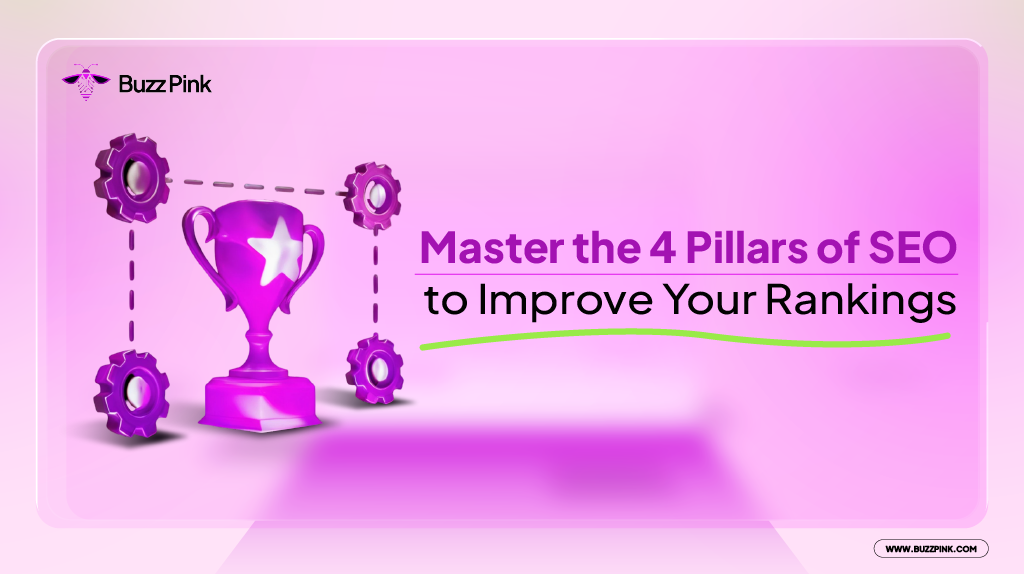Millions of websites compete to appear on Google’s first page of results. To make your site easily found by others, you must first understand SEO, or Search Engine Optimization, which is made up of four pillars.
SEO is a method of organizing and optimizing website content to appear at the top of search engines such as Google, Bing, or Yahoo. However, good SEO does more than just attract a large number of visitors; it also attracts visitors who are genuinely interested in the products or services you offer.
What Are the 4 Pillars of SEO
 The four SEO pillars are the most important components that help a website gain strength and visibility in search engines. Each pillar serves a unique purpose and complements the others. The four pillars of SEO are: on-page SEO, technical SEO, content SEO, and off-page SEO.
The four SEO pillars are the most important components that help a website gain strength and visibility in search engines. Each pillar serves a unique purpose and complements the others. The four pillars of SEO are: on-page SEO, technical SEO, content SEO, and off-page SEO.
To put it another way, on-page SEO is similar to organizing a store’s contents so that they are neat and easy to find. Technical SEO is similar to ensuring the store’s structure is strong and secure. Content refers to the appealing items you offer for sale. Off-page SEO is the process of improving your store’s reputation so that others will recommend it.
On-Page SEO
On-page SEO is how to organize the inside of a website to make it easy for visitors and search engines to read. This includes writing page titles, choosing keywords, creating a clear text structure, and writing compelling descriptions.
People are more likely to read your website if it has good on-page SEO, and Google will have an easier time understanding what your page is about. The clearer your content and structure, the more likely your page will appear in the top search results.
Technical SEO
Technical SEO focuses on a website’s technical aspects like loading speed, security, and structure. This is critical because search engines use crawlers to read website content. If Google finds your website slow or difficult to read, your pages are unlikely to appear at the top.
Technical SEO ensures that the “engine” behind your website runs smoothly, quickly, and without errors, allowing Google to easily process and display your site in search results.
SEO Content
SEO content refers to website content such as articles, images, videos, or infographics. This content must be engaging, easy to understand, and relevant to people searching on Google.
Good content will keep visitors interested, encouraging them to share your page and return to it. If your website’s content matches their search criteria, Google will consider it useful and rank it higher.
Off-Page SEO
Off-page SEO refers to activities performed outside of your website to improve your reputation and trustworthiness. Examples include obtaining backlinks from other websites, social media promotion, and collaboration with influencers.
The more trustworthy websites that link to your website, the higher your Google trust rating. Off-page SEO helps to show that your website is not only active but also well-trusted by many people.
Breaking Down Strategies of Each SEO Pillar
 Now let’s take a deeper look at each of the four main pillars of SEO, so you can better understand how they all work and how they help your website grow in the digital world.
Now let’s take a deeper look at each of the four main pillars of SEO, so you can better understand how they all work and how they help your website grow in the digital world.
On-Page SEO
On-page SEO is the most straightforward first step toward improving your website’s search engine ranking. It focuses on elements that you can edit directly on your website, such as text, images, titles, and URLs.
The primary goal is to make your website easier for users to read and for search engines to understand. For example, if you’re writing an article on “how to care for ornamental plants,” include those words in the title, first paragraph, and page URL.
Read More: Search Engine Basics: How Google Search Works for Beginners
You should also make sure your writing is well-structured, with subheadings and paragraphs that aren’t too long. This allows visitors to read more comfortably while also helping Google understand your content more quickly.
Also, remember to include images that are relevant to the content of your article. To improve SEO, name the image files with relevant keywords.
- URLs
The page address (URL) should be short and clear, containing the main keyword that describes the page’s content. Avoid random numbers or long, meaningless letters. A clean URL makes it easier for Google to understand the topic of the page and looks more professional to visitors.
- Keywords
Keywords are words or phrases that people frequently type into search engines. Use primary and secondary keywords throughout the article, especially in the title, opening paragraphs, and subheadings, so Google knows what topic you’re discussing.
- H1
The H1 is the main title of the page. It’s like the title of your article. The H1 should contain keywords and clearly describe the content so readers immediately know what to expect.
- Title Tags
Title tags appear in Google search results. Use catchy, short (around 60 characters), and include your primary keywords to make them easier for users to find.
- Header Tags
Headers such as H2 and H3 are used to divide the content of your article into sections. This helps readers quickly find important points and creates a more structured article.
- Meta Description
The meta description is a short description below the title when your page appears in Google search results. Keep it concise (around 160 characters), summarize the article’s content, and include keywords to grab readers’ attention.
Technical SEO
Technical SEO ensures that your website functions properly and is easily understood by search engines. If your website is slow, contains errors, or is difficult to navigate, visitors will leave quickly, and Google will lower its ranking.
The first step is to make sure your website loads fast. Use lightweight images, limit the number of large files, and cache to speed up page loading.
Additionally, ensure that your website’s structure is clear and easy to understand. Use a clear and simple navigation menu so that Google’s robots can crawl all pages smoothly.
Read More: What Is Keyword Placement? A Comprehensive Explanation
Finally, make sure your website is secure with an HTTPS certificate and accessible from all devices, including mobile phones.
- Loading Speed
The faster a page loads, the better the visitor experience. A slow site can make people leave quickly, so make sure all files are not too heavy.
- Crawling
Google uses robots to crawl websites. Make sure your website structure is easy to navigate by creating clear menus that aren’t too deep.
- Bounce Rate
The bounce rate indicates how quickly visitors leave your website. If it’s too high, it means they didn’t find what they were looking for. Make sure your page content is engaging to keep them staying longer.
- Indexing
Indexing means your website pages are stored by Google. Use the “robots.txt” file to control which pages should or shouldn’t be displayed in search results.
- Mobile-Friendly
Because many people browse the internet on mobile phones, websites must be able to adapt to small screens. Use a responsive design for readability on all devices.
SEO Content
SEO relies heavily on content. Good website content will draw more visitors and keep them returning. However, good content is more than just writing long pieces; it is also about meeting the needs of the readers.
You must first identify what people are looking for. For example, if they search for “how to make dalgona coffee,” your article should include steps rather than just a story about coffee.
In addition, use an easy-to-read style that is not overly formal and directly answers the reader’s questions. Do not forget to include images, tables, or videos to make your content more engaging.
Good content is not only for humans; it should also be search engine-friendly, with keywords placed strategically.
- Keyword Research
Keyword research helps you find out what people are searching for. Use keywords that are relevant to your topic and have high search volume.
- Unique and Engaging Content
Your writing should be original, not plagiarized from others. Create engaging content that includes new information to keep readers interested.
- Content Matches Search Intent
Make sure your article addresses the questions that readers are most interested in. If they are looking for solutions, offer steps. If they’re looking for inspiration, offer suggestions and examples.
Off-Page SEO
Off-page SEO helps to improve your website’s reputation beyond the site itself. Google will place more trust in your website if it is recommended or linked to by other sites.
You can accomplish this by guest posting, collaborating with influencers, or creating original, shareable content. The more people talk about your website, the more valuable it is to search engines.
Maintain an active presence on social media. Share your articles on platforms such as Instagram, X, and Facebook to increase visibility and traffic to your website.
Remember that establishing a reputation takes time. You must consistently build trust by creating high-quality content and cultivating positive online relationships.
- Create Qualified Content
Create content that is both informative and shareable. High-quality content will naturally attract a large number of links from other websites.
- Backlink Exchange
Build partnerships with other sites to provide links to each other. But do it wisely and choose trusted sites to avoid being considered spam by Google.
Looking for an Agency That Can Maintain the 4 Pillars of SEO?
 If you own a business but don’t have the time to handle all aspects of SEO, you can hire a professional agency like us, Buzz Pink. We work with businesses in a variety of industries to strengthen the four pillars of SEO in order to make their sites more discoverable and preferred by Google.
If you own a business but don’t have the time to handle all aspects of SEO, you can hire a professional agency like us, Buzz Pink. We work with businesses in a variety of industries to strengthen the four pillars of SEO in order to make their sites more discoverable and preferred by Google.
Our team understands how to efficiently and effectively organize content, website structure, and backlink strategies for each business. Buzz Pink’s results-based (ROI) approach ensures that every SEO step has a measurable impact on your company’s growth. Book us now!
Conclusion
The four pillars of SEO (on-page, technical, content, and off-page) form the basis for your website’s success in the digital world. They are all interconnected and work together to make your website more visible, faster, and trustworthy.
Understanding and implementing these four pillars will help you build a strong SEO strategy. Whether you do it yourself or hire an agency like Buzz Pink, the end result is the same: a larger website, more traffic, and a more recognizable business.
Kamila Putri is a content strategist and digital marketing expert who helps brands craft messages that resonate and drive results. With a strong foundation in SEO, brand voice, and data-driven strategy, she has produced content that performs, whether it's optimized web copy, lead-generating campaigns, or conversion-focused messaging. At Buzz Pink, she applies this expertise to help clients grow through smart, search-focused digital strategies that engage, inform, and convert.


